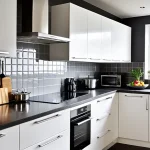Core hygiene protocols in UK commercial kitchens during peak hours
Ensuring safety when things get busy
In UK commercial kitchens, strict adherence to UK kitchen hygiene standards is vital, especially during peak hours when activity intensifies. The Food Standards Agency guidelines emphasize a structured cleaning and sanitization routine to mitigate contamination risks. This includes frequent disinfection of all food contact surfaces and equipment at regular intervals aligned with service demands.
Also read : How do UK kitchen bars create a unique atmosphere for patrons?
Staff hygiene checks are mandatory: employees must follow personal cleanliness protocols, including thorough handwashing and the use of appropriate PPE such as gloves, aprons, and hairnets. These measures reduce the transmission of bacteria and viruses. PPE use is monitored continuously to ensure compliance, particularly when handling raw ingredients.
Immediate response to spills is crucial. Spills are cleaned up promptly to prevent slips and avoid cross-contamination, which can compromise food safety. Guidelines encourage staff to address any potential hazards instantly, maintaining a safe environment while following food safety procedures.
This might interest you : What Are the Key Elements of a Successful UK Kitchen Restaurant Bar Design?
By integrating these protocols during peak hours, UK kitchens uphold the highest hygiene standards, ensuring both staff and customers are protected without disrupting workflow or service quality.
Staff training and responsibilities for maintaining hygiene
Training kitchen staff hygiene training is fundamental to ensuring food safety skills are consistently applied. Induction programs introduce new employees to essential hygiene protocols, such as handwashing techniques and safe food handling. Ongoing kitchen staff hygiene training refreshes knowledge and updates teams on any regulatory changes, reinforcing a culture of cleanliness.
Clear kitchen staff roles are crucial, especially during busy periods when lapses are more likely. Assigning specific hygiene responsibilities helps staff manage tasks without confusion. For example, one team member might oversee regular surface sanitization, while another checks temperature controls. This division ensures accountability and upholds safety standards even under pressure.
Monitoring staff compliance is vital. Regular inspections and spot checks help identify and correct non-compliance swiftly. In several kitchens, managers have adopted peer review systems, encouraging staff to support one another in maintaining hygiene standards. This practical approach not only enforces protocols but also fosters a shared commitment to food safety skills.
By integrating structured training, defined roles, and consistent monitoring, kitchens can maintain high hygiene levels and protect both staff and customers effectively.
Cleaning schedules and sanitization practices for high-traffic kitchen areas
Maintaining hygiene where it matters most
In bustling kitchens, kitchen cleaning routines are vital to ensure food safety and operational efficiency. Scheduled cleaning of food preparation surfaces and utensils must happen frequently, often between tasks, to prevent cross-contamination. For instance, rapid cleaning is essential during service hours to maintain a sanitary environment without disrupting workflow.
Deep cleaning, by contrast, is a comprehensive process typically conducted after service hours. It targets hard-to-reach spots and stubborn residues, ensuring thorough equipment sanitization. Reliable kitchen protocols distinguish between these cleaning types: rapid cleaning keeps things running smoothly; deep cleaning safeguards long-term hygiene.
The use of approved disinfectants and cleaning materials is non-negotiable. Only chemicals certified for food-contact surfaces guarantee effective microbial control without leaving harmful residues. Surfaces must be wiped, rinsed, and air-dried following proper procedures to achieve optimal sanitization.
Adopting precise cleaning schedules and using the right agents for both utensils and surfaces minimizes contamination risks, ensuring safer food preparation even under intense kitchen traffic. Clear, consistent routines empower staff to uphold cleanliness standards with confidence.
Food storage, handling, and temperature management
Ensuring food storage hygiene is essential for maintaining safety and quality, especially when operating under pressure. Careful temperature control prevents the growth of harmful bacteria, which is critical for safe food handling. Perishable items must be stored at the correct temperatures: typically below 5°C for refrigeration and below -18°C for freezing. Continuous real-time temperature monitoring and logging enable immediate detection of any deviations, allowing corrective action before food safety is compromised.
To reduce the risk of cross-contamination, it is best to keep raw and cooked foods separate, using clearly labelled containers and designated storage areas. Different tools and surfaces should be used for raw meats and ready-to-eat food. Training staff on proper procedures and emphasizing cleanliness helps reinforce these controls.
Incorporating temperature alarms and automated logs improves accountability and makes compliance straightforward. This approach ensures food stays fresh, safe, and within regulatory guidelines while minimizing waste. Focusing on these aspects creates a solid foundation for consistent safe food handling practices that protect both consumers and businesses.
Compliance with UK hygiene regulations and audits
Ensuring Food Standards Agency compliance is vital for UK kitchens to maintain high food hygiene ratings. Regular kitchen audits—both internal and external—play a crucial role in this process. These audits evaluate cleanliness, food storage, and staff hygiene practices to verify adherence to national standards.
Documentation holds significant importance. Detailed records of cleaning schedules, temperature logs, and staff training must be meticulously maintained. This documentation provides essential evidence during inspections and supports transparency.
UK kitchens often prepare for surprise inspections by establishing clear protocols and maintaining consistent cleanliness, even during busy hours. Staff are trained to follow hygiene best practices continuously, ensuring that hygiene standards do not drop when pressure mounts. This proactive approach minimizes risks of non-compliance and improves overall food hygiene ratings.
Incorporating routine audits and thorough documentation not only ensures compliance but also fosters a culture of cleanliness and responsibility. Maintaining these standards reflects positively on the establishment’s reputation and customer trust.





